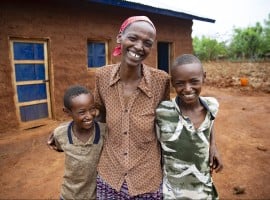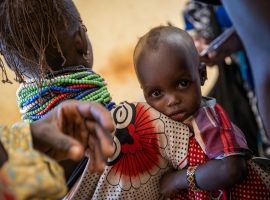
Read our 2023 annual report

Knowledge Hub
Tropical West Africa is one of the most fertile and biodiverse regions on the planet, and yet several of its constituent countries regularly feature at the bottom of indices on food security.
There’s no easy explanation as to why you’ll find Sierra Leone and Liberia among the ten “hungriest” countries in the world, as measured by the Global Hunger Index. The fallout from prolonged and devastating conflicts definitely plays a role – both countries experienced brutal civil wars towards the end of the 20th century. The bitter legacy of colonial interference is often cited as a reason for underdeveloped food production capacity across much of Africa (although Liberia was never technically colonised.) And inter-generational poverty is a key factor too.
Truth be told, like most big problems, it’s complicated.
The forests are an amazing source of food and nutrition
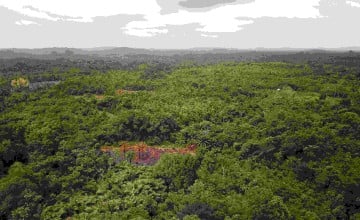
Among the many solutions in play is a return to nature’s natural bounty as a way of supplementing food produced through organised agriculture. “The forests are an amazing source of food and nutrition, but over the past decades many of our people have turned their backs on wild produce,” according to Abdul Koroma, who works for Concern in Sierra Leone. “In fact we’ve actually been destroying one very sustainable food resource in favour of a more vulnerable and less viable way of feeding our communities.”
Forage, don't fell
At certain times of the year, across tropical West Africa, you’ll see huge clouds of black smoke rising into the atmosphere, as another precious patch of bush falls to “slash and burn” agriculture. Palm and coconut trees are felled and undergrowth is set alight to create “fields” for the production of ubiquitous crops like rice, maize and cassava. While they do provide food, they don’t provide much nutrition and they quickly strip the land of it’s valuable nutrients. Soon, the destructive cycle will begin again.
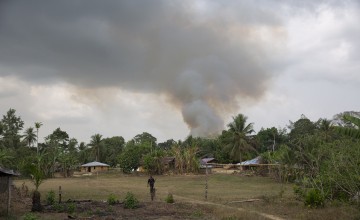
The forests are a veritable treasure trove of goodies – if you know where to look and what to look for. Yaiye Conteh does. She leads us through the bush near her home in the village of Yonkibor, Sierra Leone. “This is where we get the bush yams,” she says, and proceeds to excavate a very large gnarly-looking root from the forest floor. It’s not especially nutritious, but it is filling and a useful way to bridge the annual ‘hunger gap’. Some of the villagers here have taken to transplanting bush yam plants into plots near their homes as a more formal crop.

Elsewhere in the forest, nature’s cornucopia includes nuts, palm nuts, coconuts, wild banana and plantain, assorted berries, pineapple, mango, wild beans, and a variety of herbs. Combined with staple crops, they can contribute to a healthy, balanced diet. And the best part is… they’re free.
Iysattu Kamara of Concern says that the various efforts to help turn communities back to nature are definitely showing results and there’s a lot more potential.
Super-sized slimers
Another protein-rich food source is the wild snail. They love the dark damp forest floor, where they can slither their way through the decomposing undergrowth in a state of slimy bliss. And we’re not talking dainty escargot here. These gastropods are beasts – the Giant African Land Snail can grow up to 15 inches from snout to tail. And they can be farmed, a practice known as heliciculture.
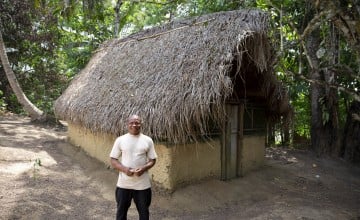
Jerry Gorr leads us to his recently-constructed snail house, a fine thatched structure on the outskirts of Guds Town in Liberia. Inside, snails in various stages of development live their days and nights in compartments designed to simulate their natural environment.
“We used to just gather snails from the bush and eat them,” Jerry says, ‘but Concern introduced us to snail farming and helped us with the design of the structure and facilitated training on how to raise them. Right now we have 50 adult snails and 460 babies. They eat papaya slices, palm cabbage, and cassava leaves.” Each compartment is secured with a mesh lid for security. “Otherwise they would wander,” Jerry explains. “They are very dogged.”
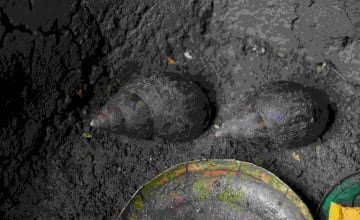
Snails are not just a valuable source of nutrition, they also fetch a fine price at market, generating a handsome return on investment. Witnessing Jerry’s success as a helicicuturalist has convinced some of his previously dubious neighbours that this is a venture worth trying, and he is happy to share the knowledge.
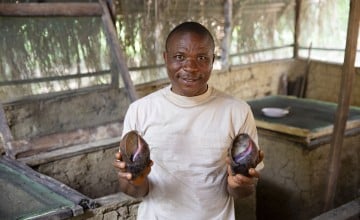
Money from honey
About a hundred miles away, in the village of Neakai, in Rivercess County, David Gargar steps into what looks like a bright yellow space suit and reaches for his helmet. “The first time we tried this it didn’t really work,” he says. “But now it’s more successful.” David guides us into the bush until we reach a wooden box on legs, in a clearing off the narrow path. “Don’t get any closer than this,” he warns. But the buzzing of busy Liberian bees is warning enough.
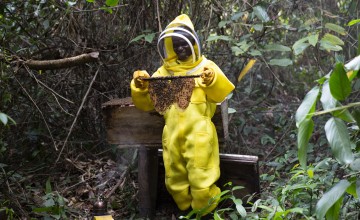
As with the snails back at Guds Town, the community here in Neakai has traditionally sourced honey from wild hives in the bush but never attempted to farm it in an organised way. Today, with support from Concern, they have successfully started two colonies and are working to attract more. The initial set of wooden hives didn’t bring the bees, so the farmers installed larger structures and varied the locations, which seems to have done the trick.
Jerry Garkpah, chair of the local Farmers Group, is enthusiastic about the new arrivals. “This is a good business, because honey is more profitable than something like palm oil, and it’s much less work. The wax from the honeycombs is also used for making candles. The only downside is that the bees can be unpredictable, but we are learning all the time.”

Nature's bounty
Of course, none of this will provide enough food to feed a nation. Staple crops grown through agriculture remain the main source of calorific intake in countries like Liberia and Sierra Leone.
One of Concern's most successful programmes in Sierra Leone is called LANN (Linking Agriculture and Natural Resource Management towards Nutrition Security), which is funded by Irish Aid and it has been running in different iterations for over a decade. Abdul Koroma is the current Team Leader. "We are working to build nutrition-smart communities, by promoting nutrition-sensitive and climate-smart organic agriculture."
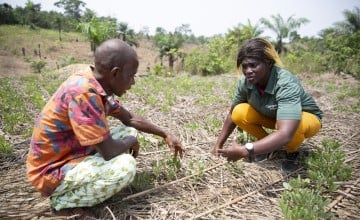
Diversification and use of improved varieties are two proven ways to make the production of these staples more efficient and effective. Climate-smart techniques can help protect agricultural land from being degraded. This involves minimal soil disturbance, mulching, and inter-cropping with legumes to inject nutrients.
Then there are the swamps. One approach that's becoming more popular is the repurposing of low-lying swampland for use in planting crops. “Managed properly, these lowland plots can produce up to three harvests in a year and will be viable for up to ten years before they need a break,” according to Sophia Johnny, a member of Concern’s Livelihoods team in Liberia.
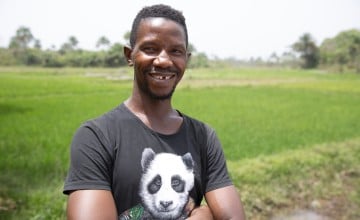
While it's not a total solution, the harvesting of wild produce and the adaptation of naturally occurring resources can undoubtedly make a solid contribution in the drive towards better food security for the rural communities of West Africa. “If every village could make appropriate use of what’s freely available all around them, while also adopting smart agriculture practices, it could be really impactful,” according to Abdul Koroma. "In fact, we believe it's essential for fostering healthy communities and securing a better future for the next generations. We’ve got the knowledge – now we just need to spread the word.”
In partnership with
Our impact in 2023
people reached through our emergency response
people reached through our health interventions
people reached through our livelihoods programmes
